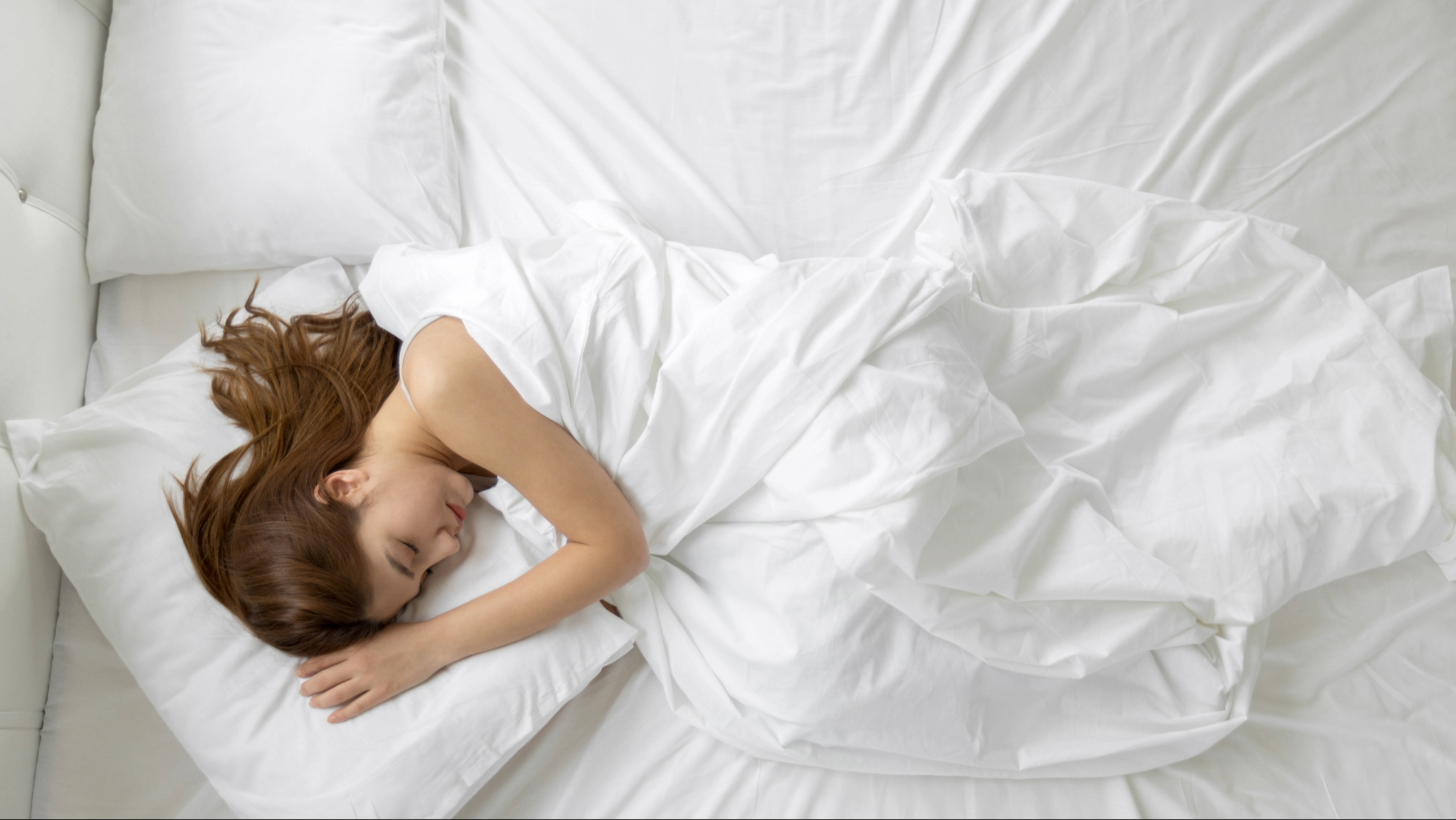How to sleep with lower back pain — 5 essential tips from the experts
We asked the experts why lower back pain is so bad for your sleep – and what you can do about it

It seems like there's nothing better for an aching body than crawling into bed, but if you have lower back pain, a good night's sleep might be a distant dream. Whether a painful lower back is keeping you up, or a long rest somehow leaves your back aching more, getting a good sleep with lower back pain can seem impossible.
Research has shown that chronic lower back pain can affect multiple aspects of sleep, from how quickly you drift off to how refreshed you feel the next morning. And with roughly 8% of the world experiencing lower back pain, that's a lot of missed sleep.
To find out why lower back pain is so detrimental to your sleep, and what you can do about it, we asked the experts. In this guide, we explore the link between back pain and sleep, plus Dr Hany Demian, CEO of the BioSpine Institute, and Dr Kevin Lees, Director of Chiropractic Operations at The Joint Chiropractic, give their advice for sleeping with lower back pain.
The relationship between lower back pain and sleep
Sleep is the time for your body to rest and recover, but if you experience lower back pain, it might not be that simple. "Sleep is closely related to pain and a lack of a good night's sleep will impact the body's ability to recover from the pain," says Dr Demian.
"When a person sleeps, joints can expand due to fluid accumulation," explains Dr Lees. "While they are up and moving around, this fluid is naturally compressed out of the joint."

"An injured joint or muscle will often have inflammation in the area, which can result in a joint becoming enlarged and very sensitive," expands Dr Lees. "Some injuries can feel worse with prolonged inactivity, sometimes resulting in increased symptoms like back pain or sciatic pain."
What does this mean for your sleep? In simple terms, being inactive for many hours can cause inflammation and sensitivity, resulting in pain, making it hard to sleep. A lack of sleep then means a lack of recovery time, which can allow the problem to continue.
What is the best sleep position for lower back pain?
Choosing the right sleep position can help alleviate lower back pain and discomfort. The best sleep position will hold the spine in a neutral angle, with no major curve or bend, to reduce the pressure placed on the back.
Side sleeping
For most people, the best sleep position for back pain is side sleeping. Lying on your side in the fetal position keeps the shoulders, spine, and hips in line, reducing strain on the lower back. Adding a pillow between the knees helps maintain this alignment, for an even healthier sleep position.
"Side sleepers typically sleep better if they slightly bend both knees and put a pillow between them," suggests Dr Lees. "This takes some of the stress off the lower back and helps to stop the lower back and pelvis from twisting."

Back sleeping
Back sleeping holds the body in natural alignment and helps distribute weight evenly, preventing pressure from building up at the touch points. "Back sleepers can reduce stress on their lower back by placing a pillow under their knees," advises Dr Lees.
While side sleeping might be our top recommended sleep position, it isn't right for everyone. Back sleeping is a good alternative that better suits certain body types and injuries.
Stomach sleeping
There is one sleep position that you should avoid if you have lower back pain: stomach sleeping. Stomach sleeping is generally considered the worst sleep position, as it flattens the curve of the spine, as well as putting pressure on it and the neck. If you're struggling to stop stomach sleeping, try using a body pillow to help you stay on your side.
Can a mattress cause lower back pain?
A mattress can exacerbate and potentially even cause lower back pain if it isn't right for your sleep position or body type. Mattresses should ideally have ample support across the lumbar region, to keep the spine at a neutral angle. If your bed lacks this support, your hips and shoulders can start sinking and your back will move out of alignment.

This can be a particular problem with old, sagging mattresses, which is why we recommend buying a new mattress every six to eight years. With frequent use a mattress will start to dip in the places you press against the surface. Your body will then sink into these impressions, which can cause the spine to move out of alignment.
If you have a heavier build (over 250lbs), it's important to choose a mattress that can support your body type. The best mattresses for heavy people combine an increased weight capacity with enhanced lumbar support, for full-body comfort.
How to sleep better with lower back pain
1. Find the sleep right position
If your lower back pain feels worse in the morning, your sleep position might be putting pressure on the injured area. "Finding the right [sleep] position is the key, but this is really dependent on the type of injury," advises Dr Demian.
Side sleeping is often recommended as the healthiest sleep position for back pain, but back sleeping might be more comfortable, depending on your injury (and body type). You might need to experiment to find the sleep position that feels best for your body.
2. Choose a good mattress and pillow
Our team at Tom's Guide has spent thousands of hours testing all the best mattresses for every sleep position, so we know first hand how the right mattress can support your body – and how the wrong mattress can make pain worse.
"Another important key is the mattress and the pillow," says Dr Demian. "I usually advise my patients to invest in a good mattress."

So what does a good mattress look like? "Not too soft and not too firm." suggests Dr Demian. The best mattresses for back pain often balance support with cushioned pressure relief.
But there are other important factors to consider when choosing a mattress, including your sleep position. The best mattresses for side sleepers have ample cushioning at the hips and shoulders, while back sleepers might require less padding. The pillow is also an important consideration. The best pillow for back pain will hold the neck at a neutral angle to the spine.
3. Heat then ice
Easing your sore back before bed can help you fall asleep faster, so you can enjoy more hours of precious recovery time. Dr Lees recommends taking a two step approach: heat, followed by ice. "While heat helps increase blood flow and may help the muscles in the lower back relax, following up with ice may help reduce inflammation before bed," explains Dr Lees.
Temperature also plays a role once you're tucked up in bed. The perfect temperature for sleep is 60-68°F, and maintaining this climate can help you stay snoozing throughout the night. If you're a hot sleeper with back pain, consider investing in a cooling mattress – tossing and turning to find the least warm spot on your bed, or disrupted sleep due to waking up hot, isn't ideal for your back.
4. Get out of bed
Lying down can make inflammation worse, which might lead to you being woken up in the night from pain. The temptation might be to stay in bed and ride it out, but Dr Lees, recommends a different approach: movement.
"Gentle motion can help reduce inflammation build-up in a joint. Some people who experience disc injuries to the lower back find relief if they wake up and walk a little during the night," says Dr Lees.

5. Stretch
Caring for your back muscles during the day can aid sleep at night (which, in turn, will help you feel better the next day). "I always suggest stretching and yoga," says Dr Demian. "Strengthening exercises will definitely ease the muscle spasms."
One simple 90-second exercise to reduce back pain is the "roadkill" position. This isn't as horrible as it sounds. Simply lie on your front and place a pillow under your chest to create "slack". Then, bend your knee to the side and hold for at least 90 seconds (though you can keep the position for up to 120 seconds), keeping the leg supported. If necessary, repeat on the other side.
Stretches for back pain can help loosen the muscles to relieve aches, however, we recommend speaking to your physician before starting a new exercise regimen for pain relief.
When to speak to your doctor about lower back pain
If you have ongoing lower back pain, or you think you might have injured your back, we recommend speaking to your doctor. Dr Demian also recommends pain medication, but as with all medication it's best to consult with your own doctor first. If the pain persists, Dr Demian suggests contacting your GP for further advice.
"Intensive measures should be considered if the pain persists beyond trying all conservative measures, life style modification, physiotherapy, and chronic pain management interventions," says Dr Demian. "If all these measures fail and the pain is still impacting the patients quality of life, surgery should definitely be considered."

Dr Hany Demian is an expert in minimally invasive spine surgery and is the CEO of the BioSpine Institute. He is the CEO and Co-founder of Pain Care Clinics/PCC in Canada.

Kevin Lees, D.C. is Director of Chiropractic Operations. After spending more than two decades as a chiropractor in-clinic, Kevin Lees, D.C. joined The Joint Corp. as Manager of Auditing and Quality in 2020. Dr Lees earned his Doctor of Chiropractic from Cleveland University-Kansas City in 2000.
Sign up to get the BEST of Tom's Guide direct to your inbox.
Get instant access to breaking news, the hottest reviews, great deals and helpful tips.

Ruth is a staff writer at Tom’s Guide, covering all things mattress and sleep. She has a deep interest in the link between sleep and health, and has tried enough mattresses to know the right bed really can make a difference to your wellbeing. At Tom’s Guide she writes to help people sleep better, from how-tos to the latest deals to mattress reviews, and has interviewed an array of specialists who share her passion. Before joining the team at Tom’s Guide, Ruth worked as a sleep and mattress writer for our sister website, TechRadar.
